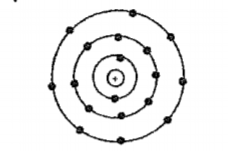Complete Solutions to EXAMPLE of chapter MODEL PAPER 1 of Class 9 book with complete answers and questions
| Class 9 | CHEMISTRY |
| Chapter | MODEL PAPER 1 |
| MAXIMUM PUBLICATION | EXAMPLE |
| Number Of Questions | 32 |
| Academic Year | 2023-24 |
Who proposed the planetary model of atom?
View SolutionThe arrangement of eight electrons in the outermost shell of an atom is called ______
View SolutionThe Catalyst used to decrease the rate of decomposition of hydrogen peroxide is ______
View SolutionThe group number of noble gases in the modern periodic table is ______
View SolutionMainly the mass of an atom depends up on the mass of (protons and neutrons, neutrons and electrons)
View SolutionThe atomic number of atom is 13. Its mass number is 27.
Write the number of electron and neutrons in the atom.
View SolutionThe atomic number of atom is 13. Its mass number is 27.
Write the electron configuration of this element.
View SolutionWhich type of bonding exist in MgO (hint atomic no. of Mg = 120 = 8)
View SolutionWhich atom loses electron? Which atom gain electron?
View SolutionHCl is a polar compound, Why HCl shows polar nature?
View SolutionBalance the following equations.
`N_2 + H_2 rarrNH_3`
View SolutionBalance the following equations.
`H_2 + O_2 rarrH_2O`
View SolutionThe electronic configuration of some elements are given below.
`12A=2,8,2`
`6B=2,4`
`16C=2,9,4`
`13D=2,8,3`
Which of these belongto the same group?
View SolutionThe electronic configuration of some elements are given below.
`12A=2,8,2`
`6B=2,4`
`16C=2,9,4`
`13D=2,8,3`
Which of these belong to same period?
View SolutionMatch the following suitably

View SolutionFind out the oxidation number of Mn in the Following compounds
Hint: Oxidation No of `K=+1`,`O=-2`
`KMnO_4`
View SolutionFind out the oxidation number of Mn in the Following compounds
Hint: Oxidation No of `K=+1`,`O=-2`
`Mn_2O_7`
View SolutionFind out the oxidation number of Mn in the Following compounds
Hint: Oxidation No of `K=+1`,`O=-2`
`MnO_2`
View SolutionThe symbol of these atoms are given below.
`6C^12`, `7N^14`, `6C^14`
Which of these are isotopes?
View SolutionThe symbol of these atoms are given below.
`_6C^12`, `_7N^14`, `_6C^14`
What is the basis of your selection?
View SolutionThe symbol of these atoms are given below.
`6C^12`, `7N^14`, `6C^14`
Write any use of an isotope
View SolutionCompare the properties of ionic and covalent compounds.
View SolutionThe symbol of certain elements are given. Write their electronic configuration and find the period and group they belong
`10Ne^20`,`12Mg^24`,`16S^32`
View SolutionThe Bohr model of an atom is given below. Analyse it and find out the following
Atomic number

View SolutionThe Bohr model of an atom is given below. Analyse it and find out the following
Electron Configuration

View SolutionThe Bohr model of an atom is given below. Analyse it and find out the following
The period and group of the element

View SolutionThe Bohr model of an atom is given below. Analyse it and find out the following
The common name of the group.

View SolutionThe electronegativity values of two elements are given below. (C=2.55 H = 2.20`)
Which type of compound will be formed if these two elements combine together? Give reason.
View SolutionThe electronegativity values of two elements are given below. (C=2.55 H = 2.20)
Draw the electron dot diagram of the chemical bonding in `CH_4` molecule.
(At.np. C=6 H=1)
View SolutionWhat is the relationship between the rate of chemical reaction and temperature?
View SolutionFill in the blanks in the following table showing how the properties varies down the group and across the period in a periodic table.

View SolutionWrite any two advantages and two limitations of the Mendeleav's periodic table.
View Solution
EXAMPLE questions and complete solutions for chapter MODEL PAPER 1 of MAXIMUM PUBLICATION of Class 9